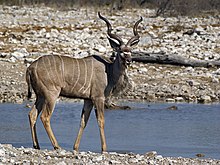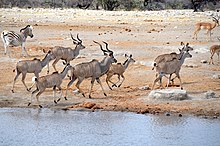Strepsiceros
| Strepsiceros | ||||||||||||
|---|---|---|---|---|---|---|---|---|---|---|---|---|

Zambezi greater kudu ( Strepsiceros zambesiensis ) |
||||||||||||
| Systematics | ||||||||||||
|
||||||||||||
| Scientific name | ||||||||||||
| Strepsiceros | ||||||||||||
| Smith , 1827 |
Strepsiceros is an African antelope - genus , their representatives, the four types of greater kudu are. The genus occurs in many African savannah areas, while the closely related genus Ammelaphus, with the species Kleiner Kudu, inhabitsa very limited range in eastern Africa .
External features

The animals reach a head-trunk length of 193 to 248 cm and a shoulder height of 121 to 157 cm. The gender dimorphism is very pronounced. Male animals weigh between 249 and 344 kg and are thus up to 150% larger than females who weigh 160 to 210 kg. The smallest species is the western great kudu ( Strepsiceros cottoni ), all others are on average larger. With the specified dimensions, the Strepsiceros species belong to the largest known antelopes after the eland ( Taurotragus ). The fur of the males is gray-brown, that of the females and young animals is medium brown and provided with six to ten white horizontal stripes. The animals have large, round ears and a bushy tail. The males carry a screw horn that is up to 105 cm long, measured along the screw turn it reaches 160 cm. The horn tips are about 80 cm apart. The appearance of the offspring corresponds to the hornless females, growing male young can be determined by the number of turns, since the first turn is formed around two years of age.
distribution
The species of Strepsiceros live in eastern and southern Africa and are mainly found in tree savannas , but not in pure forest areas or pure grassland, but they also occur near rivers in arid areas.
behavior
Mostly the females and young animals live in relatively local herds of three to ten individuals, with larger numbers they split up. These clans roam areas from 1.6 to 5.2 km² in size, in some cases they can reach 25 km². The males live in their own bachelor groups consisting of 3 to 4 individuals or are loners and only join the females during the rut . As a rule, only a single young, weighing around 16 kg, is born in the rainy season. Kudu are diurnal or nocturnal depending on the region. The diet consists mainly of leaves and young twigs, although they are not fussy. Kudu also eat plants that other animals avoid because of their toxicity. The life expectancy of the bucks is up to 8 years, that of the cows up to 15 years.
Danger
The stocks of the representatives of Strepsiceros are considered to be fairly secure in East and South Africa. Regionally, however, it is threatened, especially in its northernmost distribution area in Ethiopia , Somalia , Sudan and Chad . In addition to humans, leopards , lions and wild dogs hunt the kudu. Usually kudu try to hide from their enemies in the bushes. If this does not succeed, they can flee at high speed and long leaps. Fences, e.g. B. around farm area, are usually not an obstacle for them, as they can jump over obstacles up to 3 meters high.
species

Originally, with the great kudu ( Strepsiceros strepsiceros ), only one species was distinguished, which consisted of three to four subspecies. The differentiation of the subgroups took place on the basis of the coat color and number of stripes; it could already be partially confirmed in 2001 by DNA analyzes based on the genetic difference of an animal from northern Kenya ( S. chora ) compared to different specimens from the southern distribution area ( S. strepsiceros ) . In this study, however, no animal from the north-western population was included, which could also represent its own form ( S. cottoni ). In a revision of the hornbeams from 2011, the four subspecies were raised to species status. The following types of strepsiceros are recognized:
- Northern great kudu ( Strepsiceros chora ( Cretzschmar , 1826)); Northeast Africa from northern Kenya via Ethiopia to eastern Sudan , western Somalia and Eritrea
- Western great kudu ( Strepsiceros cottoni Dollman & Burlace , 1928); Chad , Western Sudan
- Cape great kudu ( Strepsiceros strepsiceros ( Pallas , 1766)); South Africa
- Zambezi great kudu ( Strepsiceros zambesiensis Lorentz , 1894); from southern Kenya to Namibia , Botswana and South Africa
For a long time Strepsiceros was part of the genus Tragelaphus , together with the lesser kudu ( Ammelaphus ), the nyala ( Nyala ) and the eland ( Taurotragus ). The revision of the hornbeams in 2011 led to the division of Tragelaphus into a total of five genera.
Names
The name "Kudu" comes from the language of the Khoi Khoi and was only applied to this antelope by this people, but also to the Lesser Kudu by the whites .
additional
The kudu is Zimbabwe's official heraldic animal .
See also
literature
- Peter Comley and Salome Meyer: A Field Guide to the Mammals of Namibia . Kasane 1997, ISBN 99916-30-80-5
- Colin P. Groves and David M. Leslie Jr .: Family Bovidae (Hollow-horned Ruminants). In: Don E. Wilson, Russell A. Mittermeier (eds.): Handbook of the Mammals of the World. Volume 2: Hooved Mammals. Lynx Edicions, Barcelona 2011, ISBN 978-84-96553-77-4 , pp. 614-616
- Chris and Tilde Stuart: Southern, Central and East African Mammals . Struik Publishers, 2002, ISBN 1-86872-621-5
Individual evidence
- ↑ a b c d Colin P. Groves and David M. Leslie Jr .: Family Bovidae (Hollow-horned Ruminants). In: Don E. Wilson, Russell A. Mittermeier (eds.): Handbook of the Mammals of the World. Volume 2: Hooved Mammals. Lynx Edicions, Barcelona 2011, ISBN 978-84-96553-77-4 , pp. 614-616
- ^ A b Norman Owen-Smith: Tragelaphus strepsiceros Greater Kudu. In: Jonathan Kingdon, David Happold, Michael Hoffmann, Thomas Butynski, Meredith Happold and Jan Kalina (eds.): Mammals of Africa Volume VI. Pigs, Hippopotamuses, Chevrotain, Giraffes, Deer and Bovids. Bloomsbury, London, 2013, pp. 152-159
- ↑ Louise Gray Listeners Ting, Peter Arctander: Phylogeography and conservation of impala and kudu greater . Molecular Ecology (2001) 10, 711-719. doi : 10.1046 / j.1365-294x.2001.01205.x
- ^ Colin Groves: Current taxonomy and diversity of crown ruminants above the species level. Zitteliana B 32, 2014, pp. 5-14
Web links
- Tragelaphus strepsiceros in the endangered Red List species the IUCN 2012. Posted by: Antelope Specialist Group, 2008. Accessed February 15, 2013.
- data sheet


